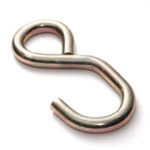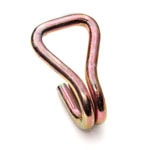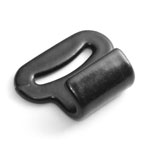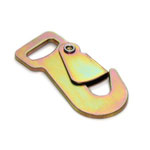Tie-downs, or tie-down straps, are often constructed using one of several different types of hooks. Tie-down hooks attach a strap to anchor points commonly found on vehicles, trailers, or other platforms in order to safely secure cargo during transport.
However, each tie-down hook is generally better suited for certain applications. Therefore, it is important to consider the cargo, the strap buckle, and the platform the cargo is being secured to when choosing a tie-down hook.
Here’s a brief overview of 5 Common Tie-Down Hooks and their Uses:
S-Hooks

S-Hooks are the most commonly used tie-down hooks, and they are typically paired with ratchet buckles. A versatile style of tie-down end, S-Hooks easily attach to vehicle bumpers, thin trailer angles, and a wide range of anchors and D-Rings to secure a varying range of cargo. Accordingly, S-Hooks are ideal for securing:
- Mountain and dirt bikes;
- Furniture and moving boxes; or
- Pallets and animal feed.
S-Hooks come in several different sizes and may be fabricated from cold rolled or stainless steel. In addition, S-Hooks are available with zinc plating or vinyl coating.
Read: 3 Common Tie-Down Buckles
Double J-Hooks

Although still considered to be all-purpose tie-down ends, Double J-Hooks, or double wire hooks, are generally preferred over S-Hooks for securing heavier cargo. Unlike S-Hooks, Double J-Hooks lie at a 90-degree angle to the plane of the strap, which provides for a direct connection to anchoring points and a flat strap surface area across cargo, preventing strap twist. Accordingly, Double J-Hooks are preferred for use with D-Rings, O-Rings, and trailer sides to secure large or heavy objects, such as:
- Motorcycles and sand rails;
- Canoes and Kayaks; or
- Welders and medium-sized tool boxes.
Double J-Hooks are available in two-prong, single-prong, and “swiveling” variants. In addition, J-Hooks are also available with zinc or vinyl coating.
Flat Hooks

Flat Hooks are frequently used in combination with winch or ratchet buckles on large flatbed trailers to secure heavy and industrial cargo. Flat Hooks are constructed from a flat piece of square steel that is bent back on itself. This design enables a Flat Hook to secure into thin, flat anchor points, such as the sides of a flatbed trailer or stake pockets. During transport, Flat Hooks are preferred for securing:
- Backhoes and excavators;
- Industrial generators and engines; or
- Quantities of guardrail ties and steel support beams.
Flat Hooks are commonly available with zinc or vinyl coating.
Read: 101 Things to Secure with Tie-Downs
Snap Hooks

Flat Hooks are frequently used in combination with winch or ratchet buckles on large flatbed trailers to secure heavy and industrial cargo. Flat Hooks are constructed from a flat piece of square steel that is bent back on itself. This design enables a Flat Hook to secure into thin, flat anchor points, such as the sides of a flatbed trailer or stake pockets. During transport, Flat Hooks are preferred for securing:
- Large tents to the ground;
- Trailers to the tow hitch of vehicles; or
- Vehicles to the back of tow-trucks.
Snap Hooks are commonly made from heat-treated alloy steel and are available with zinc plating and “twisted” variants.
Grab Hooks
Grab Hooks are frequently found in combination with winch or ratchet buckles, often used as part of cable, chain, or chain-and-webbing hybrid assemblies. Used extensively throughout the commercial and industrial sectors, Grab Hooks are preferred for securing and transporting large, high-weight objects, such as:
- Conex Boxes;
- Loads of Timber; or
- Heavy Equipment.
Grab Hooks are commonly available in stainless, alloy, and forged steel. In addition, Grab Hooks are available with zinc plating.



